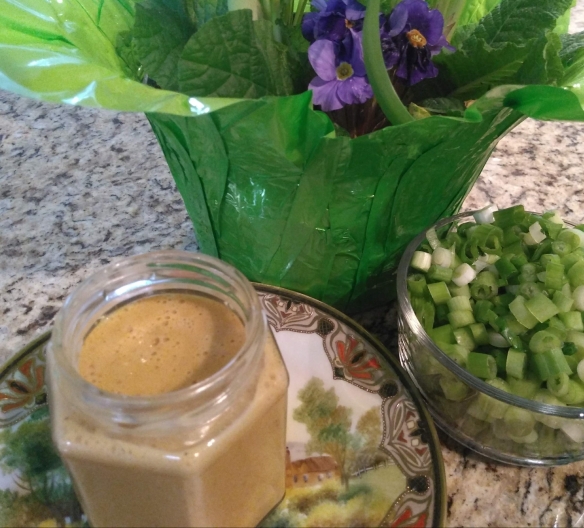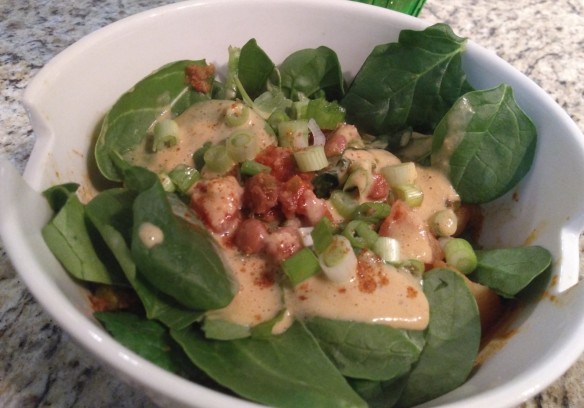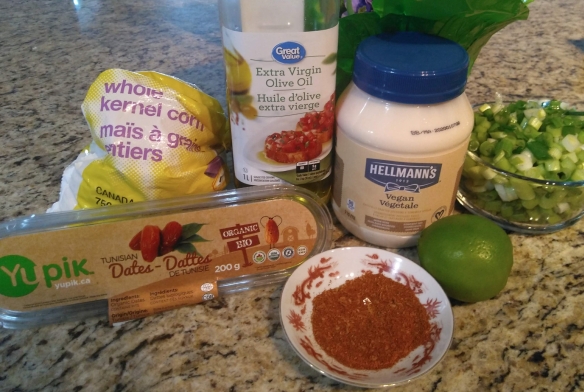Home made dressings cost so much less than store bought ones, and they taste better. They are also very easy to make and of course, you know exactly what is in homemade dressings. Once you start making your own dressings, you will never go back to store-bought because you will be able to whip up a dressing at any time that perfectly matches any meal you are making.
So, here is a set of basic instructions for vinaigrette and some ideas for how to turn it into your very own recipes based on what you have at hand.
Basic Vinaigrette Rules:
- Mix approximately 3 parts oil with 1 part acid.
- Add flavours (and textures) and mix until emulsified.
- Keep covered and refrigerated. You can re-mix if necessary, and let it come to room temperature before use.
Simple, right?
Yet the possibilities to create distinctly different dressings from this basic algorithm are endless:
- The oil can be regular olive oil, or thinner oils like canola. You can also start layering the flavours by using flavoured oils as part of the oil component- chili oil, garlic infused oil, herb oils, smoky oils, etc. You can also replace some of the oil with other thickeners (pureed veggies, as listed below, or things like nutritional yeast), although purists would say that is a no-no, as the dressing may not emulsify as well. But- this is your dressing- go keto and add in cashews, creams, or even more oils, or go oil-reduced to fit your eating pattern, or go traditional at 3:1!
- The acid choices are also endless- vinegars of any type (apple cider, red wine, rice vinegar, etc., etc., even pickle juice from a jar), citrus juices like lime or lemon, even tomato juice.
- Flavours: After you create the basic mix above in any combination that you desire, taste it and decide- do you want a traditional taste? Add Greek or Italian herbs, and perhaps a little garlic, onion powder, or flavoured salts. Is it too tart? Add some sweetness with sugar, monkfruit, honey, or pureed fruit (apples, berries, dates, etc). Even peanut butter or pureed sweet corn or roasted carrots can sweeten it. These can also make the dressing thicker and more robust, which creates textural interest for your mouth. I will describe a corn dressing recipe below, and you can check out my roasted carrot dressing here. Other sweet or combination flavours can be added with a spoonful of fancy marmalade or hot pepper jelly, or even pre-made sauces that are tucked in your fridge, like sweet BBQ sauce. Umame flavours can be added with a drop or two of fish oil, some nori or furikake, or miso. Do you like your dressing spicy? In addition to adding chili oil, you could add some chopped or pureed hot peppers, mustard, sriracha or worcestershire sauce, cajun seasoning, cayenne pepper, curry spices, hot BBQ sauce, etc. Don’t be afraid to try different combinations, either. A hot sriracha dressing tempered with a little citrus and tahini or peanut butter could be divine, for example (I don’t know, but maybe I’ll try that combo next and let you know!)
- Mix, taste again, and see if you need to add anything more. If you are not sure of a combo, start by making just a small amount- you now know the rough ratio, so you can make just a few teaspoons to taste. If you layer and layer and just hate the whole thing (it only happens rarely, believe it or not!), you are only tossing out a few spoonfuls. More frequently you will find that as you layer the flavours you start to figure out what you still need and search for things to put in until you get what you like. Write the combo down and then scale up the volume accordingly.
Here is an example of a dressing I made recently. I was meal planning for the week and I did not want contact with the grocery store crowds- a situation most of us are facing about now- so I used what I had at home. I had spinach in the fridge, as well as some frozen chili from an earlier week’s meals, so chili salad was a no-brainer. I was also yearning a bit for warmer weather to arrive and I thought about what goes with chili in the summer- Mexican corn on the cob! (roasted corn on the cob with mayo, chili powder, lime juice, and cilantro. So very yum!). I couldn’t make that of course, but I figured I could replicate some of the flavours in a dressing. I had frozen corn kernels (sweet corn kernels would work even better, but never mind), and most of the other ingredients (sadly, no cilantro), so I just followed the rules from above to create a dressing that gave me a small bit of comfort in our crazy world right now.
Mexican Corn Dressing
Because it was regular corn, I figured I might need a bit of sweetness, so I used pureed dates (BTW, I always keep a package of dates in the freezer to use as sweeteners in a pinch). I also played with the ratios a bit (based mainly on tasting as I went)- I count the olive oil, mayo, and the corn as oily parts of the 3:1 ratio, and vinegar and lime juice as the acids.
Ingredients:
- 1 cup corn, pureed
- 2 Tbsp vegan mayonnaise
- 4 Tbsp olive oil
- 4 Tbsp vinegar
- juice of 1 lime
- 2-4 tsp chili powder
- 0.25 tsp salt and pepper
- 1 date, pureed (you could use sweetener or an apple instead)
- 2 fl oz water, or as desired
Mix all the ingredients and adjust according to your taste preferences. Add water to get the consistency you like- this was much thicker and creamier than many dressings but I was looking for the rich “comfort” factor, so I left it that way.

After layering the salad, chili, and dressing, I sprinkled a few chopped green onions on top and had a nice warm chili salad. You could eat it in a corn tortilla too.

Eat well and stay well everyone!
Jo
| Nutrition Facts | |
|---|---|
| Servings 10.0 | |
| Amount Per Serving | |
| calories 81 | |
| % Daily Value * | |
| Total Fat 6 g | 9 % |
| Saturated Fat 1 g | 4 % |
| Monounsaturated Fat 4 g | |
| Polyunsaturated Fat 1 g | |
| Trans Fat 0 g | |
| Cholesterol 0 mg | 0 % |
| Sodium 64 mg | 3 % |
| Potassium 54 mg | 2 % |
| Total Carbohydrate 7 g | 2 % |
| Dietary Fiber 0 g | 2 % |
| Sugars 3 g | |
| Protein 1 g | 2 % |
| Vitamin A | 2 % |
| Vitamin C | 3 % |
| Calcium | 1 % |
| Iron | 1 % |
| * The Percent Daily Values are based on a 2,000 calorie diet, so your values may change depending on your calorie needs. The values here may not be 100% accurate because the recipes have not been professionally evaluated nor have they been evaluated by the U.S. FDA. | |

